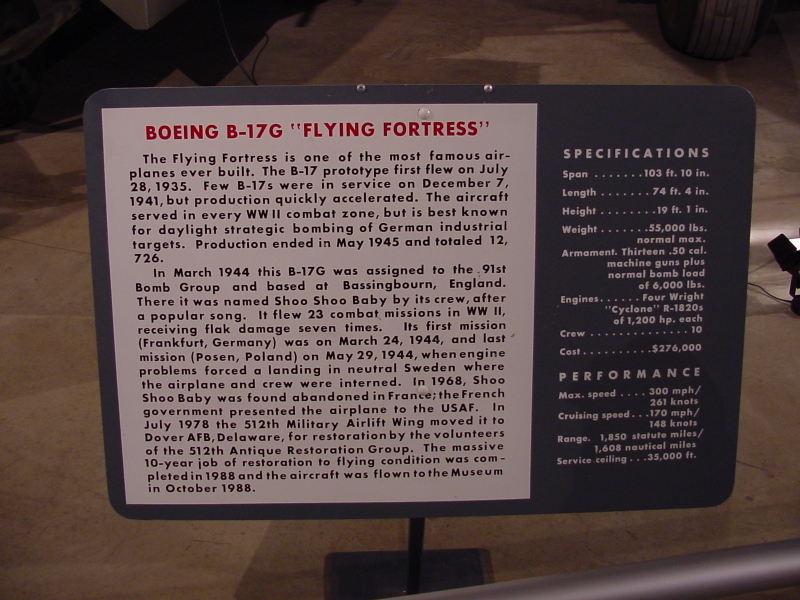| Prev |
heroicrelics.org Air Force Museum Site Index B-17 Shoo Shoo Shoo Baby Gallery |
Next |
dsc02601.jpg
The sign accompanying the B-17. It reads
Boeing B-17G "Flying Fortress"
The Flying Fortress is one of the most famous airplanes ever built. The B-17 prototype first flew on July 28, 1935. Few B-17s were in service on December 7, 1941, but production quickly accelerated. The aircraft served in every WW II combat zone, but it is best known for daylight strategic bombing of German industrial targets. Production ended in May 1945 and totaled 12,726.
In March 1944 this B-17G was assigned to the 91st Bomb Group and based at Bassingbourn, England. There it was named Shoo Shoo Baby by its crew, after a popular song. It flew 23 combat missions in WW II, receiving flak damage seven times. Its first mission (Frankfurt, Germany) was on March 24, 1944, and last mission (Posen, Poland) on May 29, 1944, when engine problems forced a landing in neutral Sweden where the airplane and crew were interned. In 1968, Shoo Shoo Baby was found abandoned in France; the French government presented the airplane to the USAF. In July 1978 the 512th Military Airlift Wing moved it to Dover AFB, Delaware, for restoration by volunteers of the 512th Antique Restoration Group. The massive 10-year job of restoration to flying condition was completed in 1988 and the aircraft was flown to the Museum in October 1988.
Specifications Span 103 ft. 10 in. Length 74 ft. 4 in. Height 19 ft. 1 in. Span 55,000 lbs. normal max. Armament Thirteen .50 cal. machine guns plus normal bomb load of 6,000 lbs Engines Four Wright "Cyclone" R-1820s of 1,200 hp. each Crew 10 Cost $276,000 Performance Max. speed 300 mph/
261 knotsCruising speed 170 mph/
148 knotsRange 1,850 statute miles/
1,608 nautical milesService ceiling 35,000 ft.

| Time picture taken | Fri Apr 25 08:37:58 2003 |
| Location picture taken | Air Power Gallery Air Force Museum Dayton, OH |
| Prev | B-17 Shoo Shoo Shoo Baby Gallery | Next |